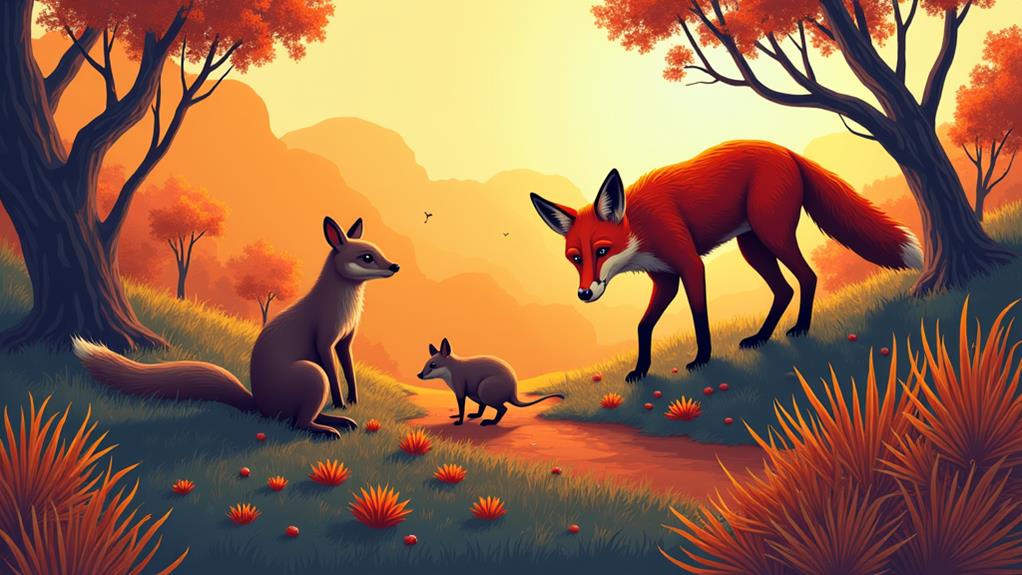Red foxes really know how to stir the pot in Australia's delicate ecosystem. They munch on native mammals like cute little bandicoots and wallabies, which puts many species at risk—some have even gone extinct! These crafty critters dig up sea turtle nests, making it hard for hatchlings to survive. Plus, they mess with the balance of local food webs, leaving everyone a bit confused. Urban foxes are even harder to manage, showing off their fancy survival skills. If you want to uncover more about how foxes have impacted our Aussie wildlife, keep exploring this fascinating topic!
Contents
Impact on Native Mammals
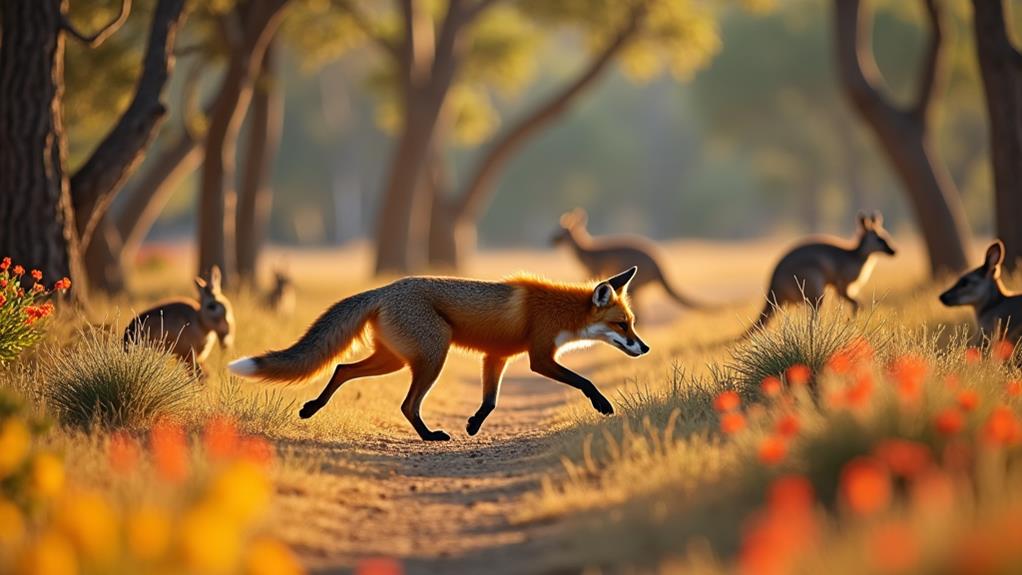
How do red foxes influence native mammal populations in Australia? Well, let me tell you, it's quite a tale!
These cunning creatures have a major hand in shaping the fate of our native species. Fox predation plays a significant role, as they mostly feast on small to medium-sized mammals. Imagine the local rabbit and possum populations suddenly taking a hit, with foxes gobbling up to 70% of their meals from these animals alone!
But it doesn't stop there. Research shows that juvenile kangaroos aren't safe either. Foxes account for 25% to 35% of their predation, making it tougher for kangaroos to bounce back. This has led to the not-so-funny extinction of ten native species, especially among those adorable Potoroidae family members, like the desert rat-kangaroo.
What's more, vulnerable species like the eastern barred bandicoot and bush-tailed rock wallaby are feeling the pressure. Their ranges are being restricted, leaving them hanging on in areas where foxes dare not tread.
As you can see, the presence of red foxes shakes up the natural balance, reminding us why every native species deserves our care and protection!
Threat to Native Reptiles
Red foxes pose a significant threat to native reptiles in Australia, although their overall dietary impact on these creatures is often overstated. You might think these clever critters are devouring all the reptiles they find, but the truth is, reptiles are pretty rare in their diet.
However, don't let that fool you; fox predation still causes serious harm, especially to vulnerable species like turtles. During nesting season, foxes dig up turtle nests, making it tough for hatchlings to survive. It's a tough break for these little guys.
On a brighter note, when foxes are removed from certain habitats, native reptiles can thrive! For instance, sand goanna populations have increased five-fold in areas where fox control is practiced.
This is a big win for local ecosystems. By letting goannas step up as top predators, we can see the beauty of a balanced ecosystem.
Predation Influencing Ecosystem Dynamics
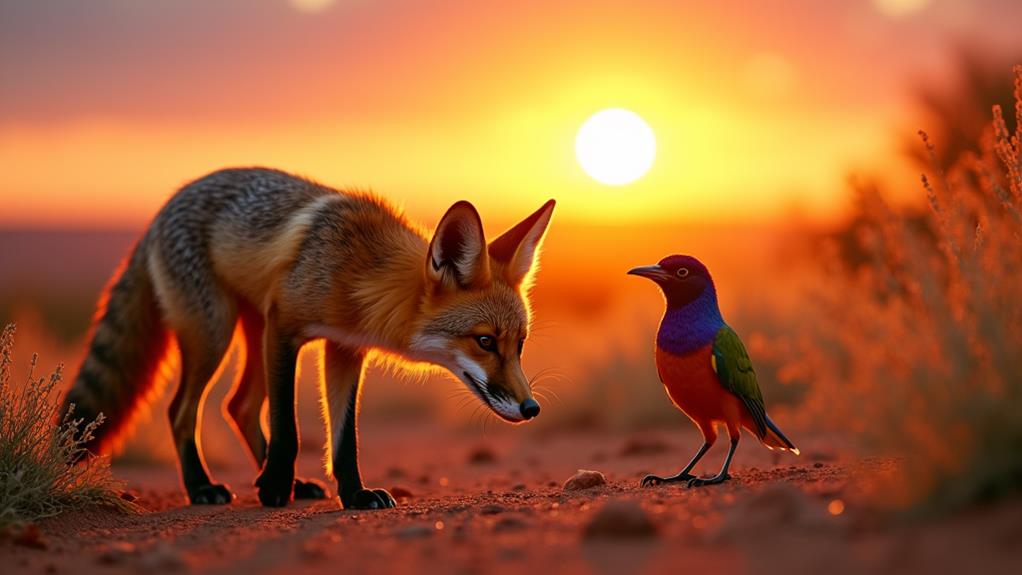
While predation is a natural part of ecosystems, the impact of red foxes on Australia's biodiversity reveals severe consequences. As these cunning creatures establish themselves as the top predator, they wreak havoc on native populations, ultimately threatening the delicate balance of our ecosystems.
The red fox, with its adaptability and diverse dietary habits, poses a particular risk to Australia's unique fauna, leading to significant ecological disruptions. Here are some heart-wrenching facts you might find shocking:
- Ten native species have gone extinct due to fox predation—who knew one small fella could cause such big problems?
- Juvenile kangaroos? A staggering 25% to 35% of them become fox chow, stunting their population growth.
- Our lovely ground-nesting birds face continuous danger, as foxes enthusiastically dig up their nests.
- Endemic marsupials are pushed to the brink, clinging on only in fox-free zones—talk about strongholds!
It's painful to see the ripple effect of their predation on the entire ecosystem. By favoring foxes, we inadvertently harm species we cherish.
Our unique native wildlife deserves protection, and understanding how red foxes influence the balance around them can inspire us to take action—for their sake and for the future of Australia's rich biodiversity. notable species include the Red Fox
Challenges in Control Efforts
The consequences of fox predation underscore the pressing need for effective control measures. Managing the red fox population in Australia isn't just about the size of their numbers; it's a fight against their incredible adaptability.
For example, urban foxes exhibit remarkable cunning as they scavenge and adjust their diets, showcasing their ability to thrive in human environments, which offers valuable lessons for understanding urban fox adaptation. You see, foxes often get wise to baiting methods, becoming bait-shy and reducing the success of control efforts. It's like they've an insider information network!
Though intensive baiting has helped increase prey species, maintaining these efforts demands a steadfast commitment. You might wonder why local eradication programs struggle—it's actually due to their sneaky behavior. Foxes are nocturnal and clever at finding dens, making it tough for management teams to hunt them down.
Plus, some native rodents have figured out how to avoid fox scents! It's a wild game of survival. That brilliance we admire in our native creatures complicates control missions even more.
While ongoing discussions about dingoes possibly managing fox populations look promising, it's clear we need integrated management strategies. It's a balancing act that requires teamwork—between humans and nature!
Ineffective Management Strategies
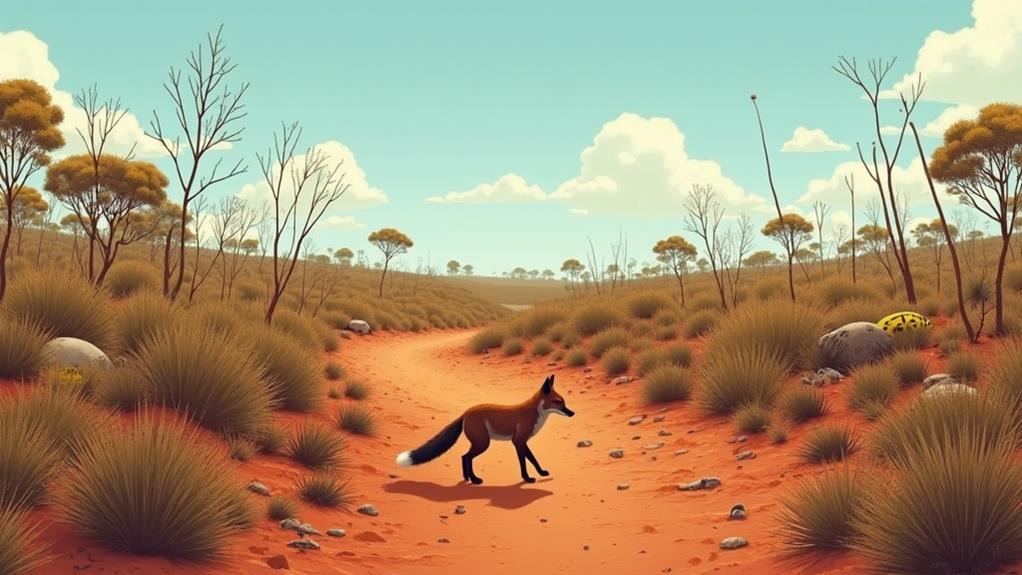
Managing red fox populations in Australia can feel like chasing your tail, especially when baiting just doesn't work as well as hoped.
Urban-dwelling red foxes are remarkably adaptable, often transforming their surroundings to enhance survivability.
You might find it surprising that even with state bounties and serious cash spent on control efforts, we're still facing challenges in eradicating these clever critters.
It's a bit like trying to outsmart a raccoon at a picnic—foxes adapt quickly, and what works today mightn't work tomorrow!
Urban fox adaptation strategies
Poor Baiting Effectiveness
When it comes to controlling red fox populations, baiting often falls short as an effective management strategy.
While it may seem like the go-to solution, the reality is that it can be hit or miss.
Here's why:
- Foxes quickly learn to avoid baited areas, meaning your efforts might just go to waste.
- Even when baiting shows localized success, it doesn't provide a long-term fix for red foxes, leaving at-risk species still vulnerable.
- Native rodents adapt to foxes, ignoring bait, which shines a light on the limitations of this approach.
- The mixed results across different ecosystems show that what works in one area might fail in another.
Challenges in Eradication Efforts
Successfully eradicating red foxes in Australia proves to be a monumental challenge due to several ineffective management strategies.
Despite our best intentions, controlling fox populations often feels like a game of whack-a-mole. You could use baiting to reduce their numbers, but many clever foxes quickly learn to avoid the bait, making those control efforts less effective. It's like teaching a dog to fetch only for it to decide chasing its tail is more fun!
Investing millions in hunting initiatives, like those in Tasmania, doesn't guarantee success, especially when hoaxes about fox sightings muddy the waters.
And let's not forget the complexity of fox behavior. They're nocturnal and have intricate denning habits, making it tricky to plan local eradication programs that stick.
In short, the task at hand often requires ongoing and resource-intensive efforts, especially for vulnerable species like the malleefowl.
It's clear that eradicating these rogue foxes isn't just a walk in the park—it's more like a hike up a steep mountain!
But with persistence and hope, we can aim for better strategies that respect our unique ecosystem.
Disruption of Food Webs
When you think about red foxes in Australia, it's easy to see them as cute and clever, but they're actually causing serious trouble in the food web.
By snacking on small native mammals and competing with our local predators, they're throwing everything out of balance.
It's a bit like bringing a party crasher to a gathering—you might end up with fewer friends and some awkward moments!
Predation Pressure on Species
Although red foxes were introduced to Australia for recreational hunting, their presence has severely disrupted local ecosystems through relentless predation on native species. The predation pressure on species like the eastern barred bandicoot and bush-tailed rock wallaby has contributed to the extinction of ten native species in Western Australia.
It's a sad situation, and here are a few hard-hitting facts to reflect on:
- Red foxes target 25% to 35% of juvenile kangaroos, impacting their chances of survival.
- They've led to a five-fold decrease in vulnerable turtle populations during nesting, which breaks up the food chain.
- Foxes have been known to hunt koalas from trees, showing just how adaptable and dangerous they are.
- Their presence allows other invaders, like feral cats, to thrive, adding more strain on native wildlife.
As you can see, the disruption caused by red foxes isn't just troublesome; it's heartbreaking.
We need to remember how interconnected our ecosystems are and aim to protect our unique native species. By understanding this issue, you can help spread awareness and inspire others to take action!
Altered Prey Dynamics
Red foxes have thrown Australia's food webs into disarray, wreaking havoc on the delicate balance of predator and prey relationships. Imagine being a small animal species, like the eastern barred bandicoot, and suddenly facing a hungry red fox!
These crafty predators have helped push many native species to the brink of extinction, directly impacting populations of small to medium-sized mammals. Can you believe that red foxes can even snag as many as 35% of juvenile kangaroos? This kind of predation leaves kangaroo numbers fluctuating wildly, which isn't great for the ecosystem.
But it doesn't stop with kangaroos. Nesting turtles also feel the pressure, as foxes dig up their eggs. You might think that a little digging won't hurt, but those lost eggs can set back turtle populations during critical breeding seasons.
Oddly enough, when foxes are removed, populations of other native species, like sand goannas, can surge by five times! This shows just how essential each creature is to the food web.
Understanding these dynamics urges us to take action. Together, we can help restore the balance in this unique ecosystem!
Competition With Native Predators
How do red foxes influence the competition among native predators? Their presence in Australia creates quite a stir in the food web, turning everything upside down.
When foxes move in, they often leave our beloved native predators, like dingoes and Tasmanian devils, scrambling for food.
Here are a few key impacts they have:
- Reduced food options: With foxes eating the same small to medium-sized mammals, it cuts down the food native predators rely on.
- Struggling species: Studies show that when foxes thrive, native species struggle. This could mean fewer Tasmanian devils in the wild!
- Wider prey range: Foxes adapt quickly, snatching up a broader variety of prey, leaving less for the other predators.
- Disrupted webs: All this competition disrupts the delicate balance of our ecosystem, affecting plant and insect life, too.
Behavioral Adaptations of Foxes
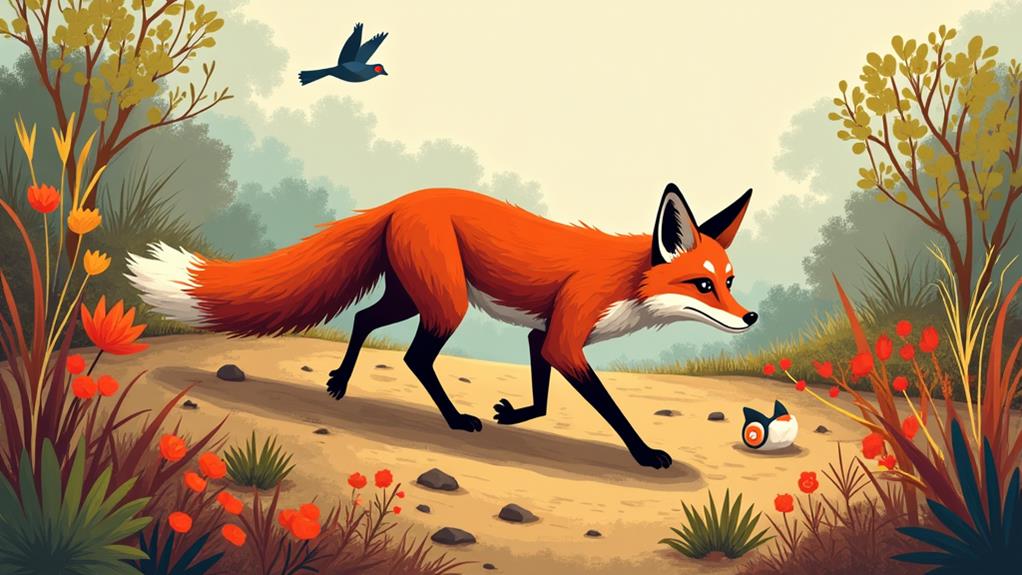
Adapting to diverse environments, foxes showcase remarkable behavioral traits that enhance their survival in Australia. Their behavioral flexibility enables them to thrive in various habitats, including urban areas.
You might find it surprising how these crafty creatures can coexist with feral dogs and cats while still preying on native wildlife.
One of their fascinating quirks is neophilia; they love exploring new things! This means they'll enthusiastically opt for unfamiliar native prey, like long-nosed bandicoots, rather than their usual fare. While this adaptability makes them successful hunters, it also spells trouble for Australia's unique species.
Foxes' sharp hearing, keen sense of smell, and ability to see well at night help them track down dinner with ease. They've even been spotted climbing trees to catch unsuspecting koalas—talk about talent!
However, their tendency to become bait-shy complicates efforts to manage these invasive species. It's a unique challenge since they learn quickly to avoid traps.
Final Thoughts
So, it turns out that the cute little red fox isn't just a charming visitor from the bush; it's actually a sneaky troublemaker in Australia's unique ecosystem! Who knew that those bushy tails could bring so much chaos? From munching on native wildlife to stirring up food webs, these foxes really know how to party—just not the kind of party we want for our native species. Let's keep an eye on them and preserve Australia's natural charm!

